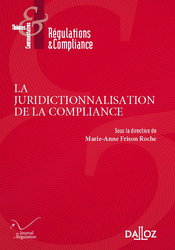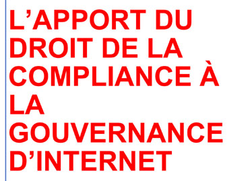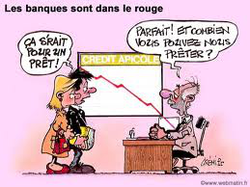Feb. 2, 2023
Thesaurus : Doctrine

► Full Reference: J. Morel-Maroger, "La réception des normes de la compliance par les juges de l'Union européenne" ("Application of compliance standards by EU judges"), in M.-A. Frison-Roche (ed.), La juridictionnalisation de la Compliance, coll. "Régulations & Compliance", Journal of Regulation & Compliance (JoRC) and Dalloz, 2023, p. 443-452.
____
📕read a general presentation of the book, La juridictionnalisation de la Compliance, in which this article is published
____
► Summary of the article (done by the author): Compliance rules are intended to pursue objectives of public interest – or monumental goals – and thereby in principle modify and guide the behaviour of economic operators. In order to achieve these objectives, the full spectrum of norms are used in compliance matters. What is and what should be the role of the judges of the European Union in the development of compliance rules ? As in domestic law, the legality of compliance standards developed by regulatory authorities has been challenged.
It will first be necessary to analyse what control the judges of the European Union have over these rules. The question arises essentially as regards the rules of soft law, the challenge of which can be considered in two ways : by way of an action for annulment and by exception by way of a preliminary ruling.
But beyond the control of the legality of compliance rules exercised by European judges, they also contribute to their application. The effectiveness of compliance rules depend above all on them being followed by those to whom they are addressed, and economic operators are undoubtedly the first actors of its success. But the judges of the European Union, competent to settle disputes concerning the application of European Union law between the Member States, the European institutions, and individual applicants, may be also be involved in ensuring the effectiveness of European compliance rules and in interpreting them.
________
Feb. 23, 2022
Thesaurus : Doctrine
Référence complète : Briatta, G., Concrete steps towards progress in the Banking Union, The European Finance Magazine, fév. 2022, p.116-.
____
Sept. 30, 2021
Thesaurus : Soft Law
► Référence complète : Parlement européen, Preventing money laundering in the banking sector reinforcing the supervisory and regulatory framework, 30 septembre 2021.
___
________
Updated: Sept. 5, 2019 (Initial publication: April 30, 2019)
Publications

♾️ follow Marie-Anne Frison-Roche on LinkedIn
♾️subscribe to the Newsletter MAFR Regulation, Compliance, Law
____
► Full Reference: M.-A. Frison-Roche, L'apport du Droit de la Compliance dans la Gouvernance d'Internet (The contribution of Compliance Law to the Internet Governance), Report asked by the French Government, published the 15th of July 2019, 139 p.
___
► Report Summary. Governing the Internet? Compliance Law can help.
Compliance Law is for the Policy Maker to aim for global goals that they require to be achieved by companies in a position to do so. In the digital space built on the sole principle of Liberty, the Politics must insert a second principle: the Person. The respect of this One, in balance with the Freedom, can be required by the Policy Maker via Compliance Law, which internalises this specific pretention in the digital companies. Liberalism and Humanism become the two pillars of Internet Governance.
The humanism of European Compliance Law then enriches US Compliance law. The crucial digital operators thus forced, like Facebook, YouTube, Google, etc., must then exercise powers only to better achieve these goals to protect persons (against hatred, inadequate exploitation of data, terrorism, violation of intellectual property, etc.). They must guarantee the rights of individuals, including intellectual property rights. To do this, they must be recognized as "second level regulators", supervised by Public Authorities.
This governance of the Internet by Compliance Law is ongoing. By the European Banking Union. By green finance. By the GDPR. We must force the line and give unity and simplicity that are still lacking, by infusing a political dimension to Compliance: the Person. The European Court of Justice has always done it. The European Commission through its DG Connect is ready.
► 📓 Read the reporte (in French)
📝 Read the Report Summary in 3 pages (in English)
📝 Read the Report Summary in 6 pages (in English)
____
► Plan of the Report (4 chapters): an ascertainment of the digitization of the world (1), the challenge of civilization that this constitutes (2), the relations of Compliance mechanisms as it should be conceived between Europe and the United States, not to mention that the world is not limited to them, with the concrete solutions that result from this (3) and concrete practical solutions to better organize an effective digital governance, inspired by what is particularly in the banking sector, and continuing what has already been done in Europe in the digital field, which has already made it exemplary and what it must continue, France can be force of proposal by the example (4).
____
📝 Read the written presentation of the Report done by Minister Cédric O (in French).
____
💬 Read the interview published the 18 July 2019 : "Gouvernance d'Internet : un enjeu de civilisation" ( "Governing Internet: an Issue of Civilization"), given in French,
📻 Listen the Radio broadcast of July 21, 2019 during which its consequences are applied to the cryptocurrency "Libra" (given in French)
🏛 Presentation of the Report to the Conseil Supérieur de l'Audiovisuel- CSA (French Council of Audiovisual) on Septembre 5, by a discussion with its members presentation (in French)
💬 Read the Interview published the 20 December 2019 : "Le droit de la compliance pour réguler l'Internet" ("Compliance Law for regulate Internet"), given in French
____
read below the 54 propositions of the Report ⤵️
March 19, 2015
Teachings : Droit de la régulation bancaire et financière, Semestre de printemps 2015
Feb. 18, 2015
Teachings : Droit de la régulation bancaire et financière, Semestre de printemps 2015

Le secteur bancaire et financier d'une part et le droit de la concurrence correspondent à deux logiques différentes, alors même que le droit de la concurrence interfère nécessairement sur ces secteurs, puisque les entreprises financières et bancaires proposent des services à des consommateurs finaux. C'est pourquoi, bien qu'au départ protégé de l'applicabilité du droit de la concurrence en raison de sa spécificité, ces secteurs ont été petit à petit conquis. Ils l'ont été par le biais du contrôle des concentrations, par la sanctions des pratiques anticoncurrentielles et par la prohibition des aides d'État. La directive MIF 1 a adhéré pleinement au principe concurrentiel.
Mais après ce premier temps, un nouvel équilibre est en train de se mettre en place. Ainsi, la directive MIF 2 a tiré les leçons des dégâts engendrés par un principe de concurrence sans partage sur les marchés des instruments financiers. De la même façon, les juridictions supérieures ont infléchi le principe de concurrence en reconnaissant la nécessité d'organiser des relations interbancaires, notamment dans les moyens de paiement. L'on constate d'ailleurs que la Commission européenne a su infléchir les principes pour gérer la crise financière de 2008-2009. Plus encore, la construction de l'Union bancaire crée un nouvel équilibre institutionnel entre logique concurrentielle et logique bancaire, en créant un continuum entre Banque centrale et Commission.
Lire la problématique de la leçon.
Regarder les slides de la leçon.
Voir bibliographie ci-dessous

Feb. 11, 2014
Publications

Ce working paper a été rédigé pour servir de base à un rapport de synthèse dans un colloque et pour servir de page à une publication.
Il y a trente ans était adoptée celle que l'on désigne avec respect la "Loi bancaire". On l'évoque avec nostalgie.
A écouter les orateurs, à lire les contributions, l'on mesure que le texte a certes été abîmé par de multiples textes qui a ajouté de multiples dispositions, tirant à hue et à dia le texte d'origine, le déformant à force de le ployer à de multiples fins.
Mais surtout la Loi bancaire de 1984 avait avant tout pour objet la relation entre le banquier et son client, entreprise ou particulier, et pour objet juridique le contrat, conséquence naturelle. Au fil des décennies, c'est le financement de l'économie et la gestion des risques qui ont pris le devant de la scène et la régulation bancaire et financière qui remplace le droit bancaire, déclinaison du droit civil : le droit des marchés a remplacé le droit des contrats.
L'Union bancaire va finir la transformation et la notion de "place" devient centrale avec les interrogations juridiques sur la monnaie qui se renouvellent. C'est pourquoi nous sommes au "milieu du gué".
Nous verrons dans 30 ans si les contrats se seront dissous dans la régulation bancaire et financière. Sans doute pas. Mais la régulation est déjà devenue première.